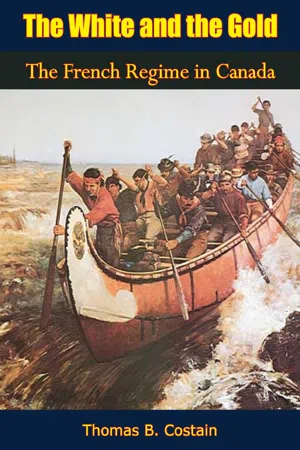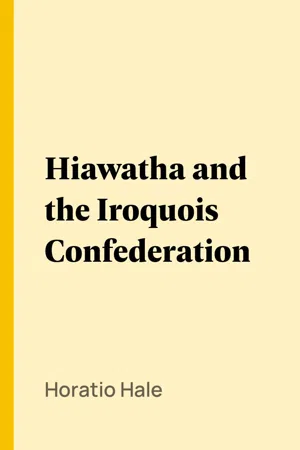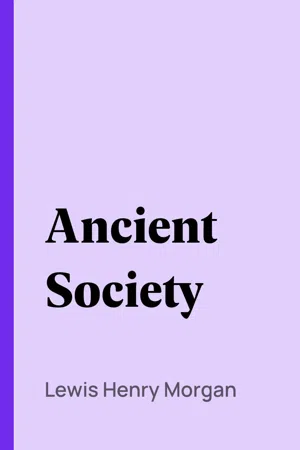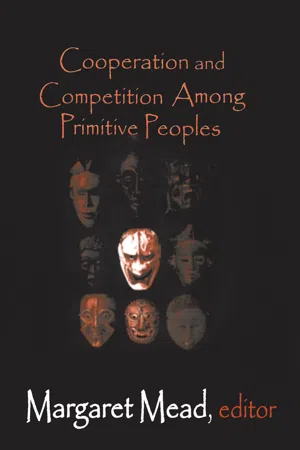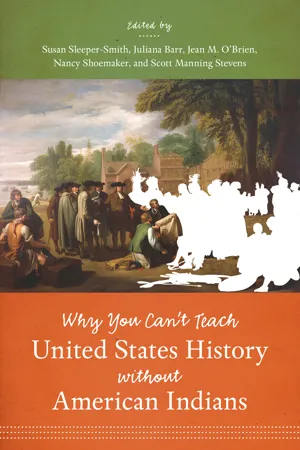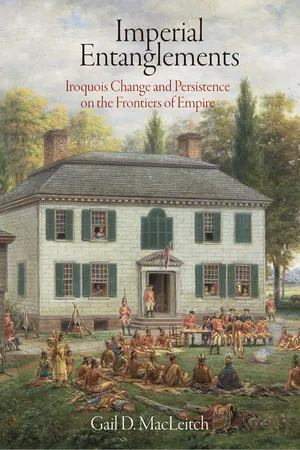History
Iroquois
The Iroquois were a group of Native American tribes in the northeastern United States, known for their confederacy called the Haudenosaunee. They were skilled in agriculture, hunting, and warfare, and their society was matrilineal, with women holding significant political power. The Iroquois played a key role in the early history of North America, particularly in their interactions with European colonizers.
Written by Perlego with AI-assistance
Related key terms
6 Key excerpts on "Iroquois"
- eBook - ePub
The White and the Gold
The French Regime in Canada
- Thomas B. Costain(Author)
- 2018(Publication Date)
- Borodino Books(Publisher)
The fifty sachems gathered by established custom in the council house at the Valley of Onondaga, the Onondagas being the tribe centrally located. Generally the whole Iroquois population would move out of the rolling hills and valleys of their fruitful country and follow their leaders to Onondaga, there to sit in dense groups and hold their own conclaves while the great men talked in the council house. The concerted wisdom of these open-air forums, including those of the women who were always given a hearing, would be conveyed by delegates to the solemn council of the sachems and would be fully considered before any final decisions were reached.Once made, a decision had the unanimous support of all the five Nations. There was no such thing as conscription, however, and a man who did not want to fight was not compelled to do so. If war had been decided upon, the braves would leave with their tiny supplies of ground corn and maple sugar (it was their custom to live off the land), their guns and tomahawks, knowing that each stage of the campaign ahead of them had been thought out in advance. Nothing had been overlooked. The Iroquois were incapable of such desultory conduct as the Hurons of St. Ignace had shown, smoking the winter months away and dreaming of the strong defenses they were going to build.It was an intense pride of race which made them conquerors. In the early years of the eighteenth century they admitted to their confederacy a tribe which had been forced out of South Carolina and had migrated to the North, the Tuscaroras. They called themselves thereafter the Six Nations, but their attitude toward the Tuscaroras was always condescending and resentful.It was not difficult for a race as well organized as this to prevail over the shiftless and scatterbrain tribes around them. After the Hurons had been eliminated, the Five Nations struck savagely at others nearer to hand. The following year they captured the main village of the Neutrals and drove the vanquished people into the woods, where most of them died of starvation. The Eries, who lived in the fertile country south of the lake of that name, were the next victims. Carrying their canoes as shields, the Iroquois boldly rushed the palisades and then employed the canoes as scaling ladders. Such resourcefulness could not fail of success. They swarmed over the walls and in a single day of blood and fire they wiped the Eries from the face of the earth. The Andastes proved more worthy opponents and it took years to subdue them; but finally the plans hatched by the fifty wise men in the council house at Onondaga proved effective, and the Andastes also ceased to exist as a separate tribe. - eBook - ePub
Hiawatha and the Iroquois Confederation
A Study in Anthropology. A Paper Read at the Cincinnati Meeting of the American Association for the Advancement of Science, in August, 1881, under the Title of "A Lawgiver of the Stone Age."
- Horatio Hale(Author)
- 2007(Publication Date)
- Perlego(Publisher)
A singular fortune has attended the name and memory of Hiawatha. Though actually an historical personage, and not of very ancient date, of whose life and deeds many memorials remain, he has been confused with two Indian divinities, the one Iroquois, the other Algonquin, and his history has been distorted and obscured almost beyond recognition. Through the cloud of mythology which has enveloped his memory, the genius of Longfellow has discerned something of his real character, and has made his name, at least, a household word wherever the English language is spoken. It remains to give a correct account of the man himself and of the work which he accomplished, as it has been received from the official annalists of his people. The narrative is confirmed by the evidence of contemporary wampum records, and by written memorials in the native tongue, one of which is at least a hundred years old.According to the best evidence that can be obtained, the formation of the Iroquois confederacy dates from about the middle of the fifteenth century. There is reason to believe that prior to that time the five tribes, who are dignified with the title of nations, had held the region south of Lake Ontario, extending from the Hudson to the Genesee river, for many generations, and probably for many centuries. Tradition makes their earlier seat to have been north of the St. Lawrence river, which is probable enough. It also represents the Mohawks as the original tribe, of which the others are offshoots; and this tradition is confirmed by the evidence of language. That the Iroquois tribes were originally one people, and that their separation into five communities, speaking distinct dialects, dates many centuries back, are both conclusions as certain as any facts in physical science. Three hundred and fifty years ago they were isolated tribes, at war occasionally with one another, and almost constantly with the fierce Algonquins who surrounded them. Not unfrequently, also, they had to withstand and to avenge the incursions of warriors belonging to more distant tribes of various stocks, Hurons, Cherokees and Dakotas. Yet they were not peculiarly a warlike people. They were a race of housebuilders, farmers, and fishermen. They had large and strongly palisaded towns, well-cultivated fields, and substantial houses, sometimes a hundred feet long, in which many kindred families dwelt together. - eBook - ePub
Ancient Society
Or, Researches in the Lines of Human Progress from Savagery, through Barbarism to Civilization
- Lewis Henry Morgan(Author)
- 2014(Publication Date)
- Perlego(Publisher)
Gä-ne-o-di′-yo, one of the eight Seneca sachems, his successor would be elected by the Turtle gens in which this sachemship was hereditary, and when raised up by the general council he would receive this name, in place of his own, as a part of the ceremony. On several different occasions I have attended their councils for raising up sachems both at the Onondaga and Seneca reservations, and witnessed the ceremonies herein referred to. Although but a shadow of the old confederacy now remains, it is fully organized with its complement of sachems and aids, with the exception of the Mohawk tribe which removed to Canada about 1775. Whenever vacancies occur their places are filled, and a general council is convened to install the new sachems and their aids. The present Iroquois are also perfectly familiar with the structure and principles of the ancient confederacy.For all purposes of tribal government the five tribes were independent of each other. Their territories were separated by fixed boundary lines, and their tribal interests were distinct. The eight Seneca sachems, in conjunction with the other Seneca chiefs, formed the council of the tribe by which its affairs were administered, leaving to each of the other tribes the same control over their separate interests. As an organization the tribe was neither weakened nor impaired by the confederate compact. Each was in vigorous life within its appropriate sphere, presenting some analogy to our own states within an embracing republic. It is worthy of remembrance that the Iroquois commended to our forefathers a union of the colonies similar to their own as early as 1755. They saw in the common interests and common speech of the several colonies the elements for a confederation, which was as far as their vision was able to penetrate.The tribes occupied positions of entire equality in the confederacy, in rights, privileges and obligations. Such special immunities as were granted to one or another indicate no intention to establish an unequal compact, or to concede unequal privileges. There were organic provisions apparently investing particular tribes with superior power; as, for example, the Onondagas were allowed fourteen sachems and the Senecas but eight; and a larger body of sachems would naturally exercise a stronger influence in council than a smaller. But in this case it gave no additional power, because the sachems of each tribe had an equal voice in forming a decision, and a negative upon the others. When in council they agreed by tribes, and unanimity in opinion was essential to every public act. The Onondagas were made “Keepers of the Wampum,” and “Keepers of the Council Brand,” the Mohawks, “Receivers of Tribute” from subjugated tribes, and the Senecas “Keepers of the Door” of the Long House. These and some other similar provisions were made for the common advantage. - Margaret Mead(Author)
- 2018(Publication Date)
- Routledge(Publisher)
1 Though this is technically untrue, it suggests that the influential position of Iroquois women was worthy of note even to such closely allied peoples as the Neuters. To what degree the political notoriety of the League depended upon superior cultural integration, as opposed to historic accident, cannot be determined; whatever the cause, the Iroquois alone of the peoples of their area integrated widespread social forms into a political machine with definite nationalistic ideas.Sketch of Iroquois Culture.— Their League, or political coalition of tribes symbolically called the Longhouse, was organized on a plan which intricately reduplicated the intricate structure of the relationship groups which existed in the family longhouse—the clan and moiety. Its five component tribes—Mohawk, Onondaga, Seneca, and Cayuga (and later Tuscarora)—were each represented in annual council by their sachems.2 Its political policy was to expand by adopting and assimilating those tribes who would readily submit and by exterminating the recalcitrants. Its ultimate purpose, in Iroquois phrasing, was to create and maintain a large and peaceful pan-Indian state.Men were warriors, hunters, and politicians, while women tended the fields, managed their households, and supervised the succession of family titles. Men made weapons and carved wooden ornaments.3 Women wove mats, shaped bark utensils for household use, and beaded their garments in flowery patterns. Division of technical specialties, and secular activities in general, into male and female categories tended to place men and women in separate occupational groups. But in the domain of religion and ceremony, categories were not so strict; ceremonial offices were divided equally between the two sexes.The year was segmented by periodic thanksgiving festivals determined by phases in the maturation of corn, beans, and other food plants. From the planting festival in the spring until harvest in late autumn, life was concerned chiefly with agriculture and village activities. But when the harvest was complete and the supernatural powers of plant growth were dormant, families wandered off in small groups to trap and hunt; the village was deserted except for the small children and the very old. Toward the end of February they returned to prepare for the Dream Festival, at which the pent-up repressions of a year’s well-ordered life were discharged in a single purge of emotional excitement.- Susan Sleeper-Smith, Juliana Barr, Jean M. O'Brien, Nancy Shoemaker, Scott Manning Stevens, Susan Sleeper-Smith, Juliana Barr, Jean M. O'Brien, Nancy Shoemaker, Scott Manning Stevens(Authors)
- 2015(Publication Date)
- The University of North Carolina Press(Publisher)
The Haudenosaunee, or people of the Great League of Peace and Power, had long been united diplomatically, centered in lands in what is now upstate New York. They were indeed powerful, though their enemies would not have described them as peaceful. They fought hard, especially against Algonquian enemies, in a series of “mourning wars” in the seventeenth century. In part, Iroquois people were seeking captives, mainly women and children, and their own matrons had an important role in deciding on war and peace, captivity and death. Women in these communities had long had the power to select chiefs, participate in councils, and wage war. 14 They were also central to the agricultural labor that provided resources, stability, and power. In 1763, Mohawks explained to an Indian agent that women were “the Truest Owners, being the persons who labour on the Lands.” 15 As one historian has it, “an Iroquois town was largely a female world.” 16 The Haudenosaunee people initially followed a policy of neutrality in the American Revolution. Most of the Iroquois Confederacy, long allied to the British, had little interest in joining in the patriot cause. However, a series of incidents led to a declaration of loyalty to the British side, by all but the Oneida and the Tuscarora. When this fateful resolution passed the council of warriors, records noted that “the mothers also consent,” indicating the continued political standing of Iroquois matrons. One of the best-known of these women, central to the revolution, is Konwatsitsiaienni, or Molly Brant, recognized in Iroquois communities as the widow of Sir William Johnson, the prerevolutionary British agent to the Indians. Her arguments were critical in persuading Mohawks and others to support the British, since “one word from her goes farther with them than a thous[an]d. from any White Man.” 17 Thanks to the efforts of Konwatsitsiaienni, her brother, and others, Mohawks and others began fighting with the British- eBook - ePub
Imperial Entanglements
Iroquois Change and Persistence on the Frontiers of Empire
- Gail D. MacLeitch(Author)
- 2012(Publication Date)
- University of Pennsylvania Press(Publisher)
In 1764 Oneida headmen from Oquaga asked the superintendent to provide them with paper passports so that they could control the movements of younger men. By assuming the right to dispense passes they could compel warriors to obtain “the Consent of their Councellors” before they left their village. Headmen called on Johnson in 1770 to deter warriors from going to war with the Cherokees, causing warriors to be “not well pleased.” Older men were also drawn to Christianity as a means to augment their authority over unruly warriors, particularly with its message of temperance, submission, and restraint. Through preaching and practicing the gospel, they hoped to regain the respect of warriors, thus bringing them back into their fold. In a noted act of deference, Oquaga warriors in 1764 told their headmen, “Your Example of Piety has entirely, reclaimed us, insomuch, that we are to assure you we shall quit the immoderate use of Liquor, and other Vices, and be entirely directed by your Councils.” 52 Yet such statements often lacked substance as warriors continued to resist constraints. This generational conflict between warriors and chiefs was not simply about the right of younger men to wage war when they wanted but pointed to much larger issues about how power was to be attained, distributed, and exercised along gendered lines in Iroquois society. As Iroquois men and women—to varying degrees—renegotiated gendered roles and relations, they were also involved in the no less complex task of reconceptualizing their ethnic identity and relations with non-Iroquoians. The Iroquois had long applied kinship terms to describe their connection with European settlers. Through fictive and actual adoption they incorporated outsiders into their lineages. Dependent on Iroquois neighbors as economic partners and martial allies, frontier settlers had responded in kind. Consequently, for decades the imperial frontier was characterized by a high degree of cultural fluidity
Index pages curate the most relevant extracts from our library of academic textbooks. They’ve been created using an in-house natural language model (NLM), each adding context and meaning to key research topics.
